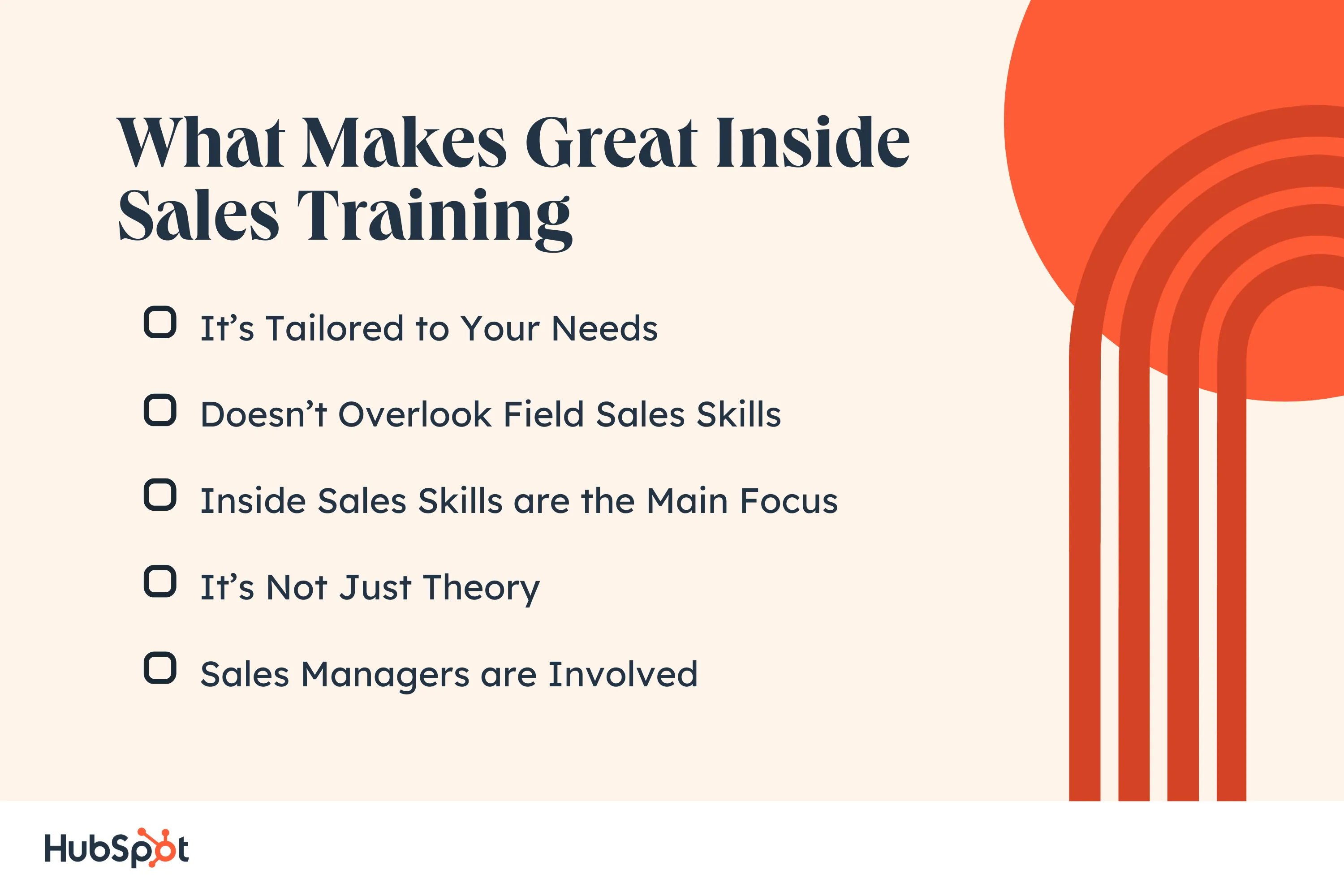Table of Contents
- What is inside sales training?
- Inside Sales Training Methods
- What Makes for Great Inside Sales Training (+Tips)
- How to Measure Your Impact
What is inside sales training?
Inside sales means selling remotely rather than traveling to meet customers (outside sales). Instead of face-to-face meetings, inside salespeople will use the phone, email, or social media to sell products and services. Inside sales is generally popular among niches like B2B, tech, SaaS, and vendors selling high-ticket services/products.
Inside sales training teaches reps how to sell remotely and helps them perform better at the role. Because of the nature of inside sales, training usually focuses on outreach methods, using data to persuade, and sales tools.
The Benefits of Inside Sales Training
Not sure whether to invest in inside sales training for your team? Here are five reasons you should.
.webp)
1. Improve Sales Revenue and Performance
Wilson Learning highlights a 43% increase in performance — with performance measured in sales revenue — after training salespeople only. Then, with the addition of manager coaching, sales performance (revenue) increased 24% to 67% overall.
The State of Sales report mirrors the positive link between training and rep performance. The Salesforce research found that 26% of high-performing sales reps receive weekly one-to-one coaching.
2. Set Sales Reps Up for Long-Term Success
To get the highest ROI, you need to see sales training as a marathon, not a sprint. But according to Mindtickle, 85% of reps report “being coached on closing open deals” while only
24% are “coached on long-term skills.”
Your sales team will need regular training to keep up with industry demands and be successful long term. That means training that goes beyond the onboarding stage. And while it’s undoubtedly essential to cover sales basics, you must train reps on specific skills, too.
3. Close the Talent and Skills Gap
According to Gartner, 78% of CSOs say it’s “difficult or somewhat difficult to attract high-quality sales candidates.” Further, only around three candidates are available for every B2B sales job vacancy.
Alongside an already shallow talent pool, the skills needed to succeed in inside sales (even for experienced reps) are evolving, too. Inside sales managers not only have to train new reps on the company's specific sales model but also on sales and business basics.
To Bob Perkins, founder of AA-ISP, the problem has two causes. “Inside sales is growing so fast, and there are so many jobs that need to be filled that hiring managers are forced to hire less experienced people,” he said.
Inside sales training can help you close the talent gap by upskilling your existing reps in line with industry changes. That could mean you don’t have to go out to hire in the first place. Then, 48% of employees “agree that training opportunities were a factor in choosing their current company.” (SHRM, 2022).
If you do need to hire, investing in the continuous development of your employees may help you attract top talent. Plus, it provides a structured way to get new talent up to speed with any critical skills needed.
4. Reduce Employee Churn
Companies can spend anywhere from $10,000 to $15,000 hiring a single sales rep (ATD Research). Employee retention should be a top priority if you want to reduce recruitment costs. Spoiler alert: Inside sales training can help.
Investing in an employee's professional development makes you more likely to retain them. In fact, Zippia found that “94% of employees would stay longer if companies invested in their careers.”
But it’s not just about giving your existing team upskilling opportunities. The Skills Advantage report shows us how important teaching your team relevant skills is. For context, employees who feel their skills don’t deliver value are ten times more likely to start job hunting.
5. Leverage AI Tech
68% of business leaders say AI can help them scale their company in a way that wouldn’t be possible otherwise (The State of AI Report). And 65% of business leaders see AI impacting productivity like the Industrial Revolution did.
Regarding sales specifically, sales pros reportedly save over two hours a day by automating manual tasks with AI. Welcome news, given that “non-selling activities take up a significant portion of the sales team’s time,” according to AA-ISP's 2023 Survey.
.webp)
Looking at inside sales activities, 86% of sales pros say generative AI helps them craft effective outreach messages to prospects. A point echoed by the 72% who say using AI helps them build rapport with prospects faster.
So the question is: Even if you’ve invested in AI solutions, are you and your inside sales team ready to use them to the best effect? Robust inside sales training will help you put your best foot forward with AI.
Inside Sales Training Methods
We cover general inside sales training methods and specific training activities based on generational preferences (per the Salesforce State of Sales report). You or an external provider might offer one, a mixture, or all of the following inside sales training ideas.
General types of inside sales training:
- In-person training. These training sessions are delivered face-to-face in a classroom or similar environment. You might provide in-person training, either one-to-one or as group coaching.
- E-learning. In this case, you remotely offer every element of your inside sales training. Everything is delivered and completed online, from coaching sessions, role-playing, workbooks, and assessments.
- Blended learning. This approach combines e-learning and in-person to deliver hybrid inside sales training. A trainer might provide a training session remotely through video and then follow up with a classroom-based assessment.
- Performance reviews. Your performance reviews are not just an opportunity to celebrate success and discuss improvement. You can use them to train your inside sales team, too. To engage Gen Zers, use monthly performance reviews as a coaching opportunity.
Examples of specific inside training activities:
- Training materials/resources. Quizzes, checklists, handbooks, or research papers are examples of training resources. According to Saleforce’s report, this type of activity is most popular among baby boomers.
- Sales strategy reviews. Periodically review the decisions, actions, and goals behind your team’s sales strategy — then give feedback. If you’re running this activity and want to make it more interactive, consider a sales-customer role play to act out the strategy in different scenarios. Gen Xers and Millennials most value this coaching activity.
What Makes for Great Inside Sales Training (+Tips)
Whether you outsource in-person training to a provider or go in-house with coaching activities — great inside sales training has the following in common.

It’s Tailored to Your Needs
Effective sales — be that your strategy, messaging, customer profiles, etc. — leverages the power of specificity. And so too should your sales training. Short story shorter: Great inside sales training isn’t generic. A trainer should tailor it to your specific industry, product/service, and company goals. But what does that look like exactly?
Let’s say you’re in B2B SaaS. Making generalist training (like public webinars or events) available to your sales team might benefit you. They’re typically more cost-effective, after all. And your reps may leave with a few new gems of knowledge.
However, B2B inside sales training focusing specifically on using data to sell remotely is more likely to reflect the needs of your SaaS model. That’s opposed to a seminar focusing on general sales prospecting, for example.
Pro tip
If you’d like to run effective inside sales training in-house, try incorporating real/relevant sales scenarios from your company. So, role-playing a sales scenario (like overcoming a tricky case of sticker shock) that actually happened.
You could be the customer/client, recreate their objections to your pricing, and ask reps how they’d respond. Then, close up with how you initially overcame the sticker shock.
Doesn’t Overlook Field Sales Skills
The role of an inside sales rep has broadened significantly due to shifting sales models. Historically, field and inside sales reps worked together on the same deals, albeit performing different tasks. This configuration is known as a team-selling model.
But as Bob Perkins, founder of AA-ISP, points out, the discrete model — where inside sales reps work separately from field reps and are responsible for their own quotas — is gaining in popularity.
And this means all the tasks traditionally associated with field reps are now expanding into the realm of inside sales. In short, great inside sales training also accounts for these field skills.
Pro tip
According to Perkins, basic skills like "relationship development, proposing, presenting, negotiating, and closing” are now required by inside sales. So, if you’re training in-house, remember to dedicate some time to these skills, too. But, even if the sales skills you cover are generalist (i.e., sales prospecting), make sure the training is specific to your company's needs.
Inside Sales Skills are the Main Focus
The demands of inside sales are constantly evolving, and so are the skills needed to succeed in the role. With this in mind, Perkins issued a rallying cry to inside sales training companies, specifically.
“Training firms need to change with the times,” he said. “There are a lot of good firms, but they don’t deal with the nuances and requirements of today's inside sales rep. They don't talk about social media, how to do a great remote presentation, pre-call research, or prospecting at the top of funnel.”
Developing AI skills for inside sales (so reps can spend more time actually selling) could be another area to cover. Specific skills might be finding company decision-makers at scale using AI or using generative AI to craft effective follow-up emails.
Pro tip
To deliver excellent training in-house, heed Perkins’ warning and focus your efforts on teaching specific inside selling skill requirements. For example, if you focus on presenting, cover how to deliver strong presentations remotely.
You could also discuss securing follow-ups with prospects during remote meetings. It could be as simple as coaching your reps to always schedule a reconnect before ending a call.
HubSpot Principal Account Executive Kristen Kelley recommends this approach because “Reconnects help you maintain control of the process. Otherwise, you’ll waste time and energy chasing your prospect on the next steps."
It’s Not Just Theory
Effective inside sales training doesn’t just go over theory. It places relevant theory within the proper context and drives learning through the right actions. Doing so doesn’t just make the learning stick — it also front-loads your reps' buy-in.
Let’s say you’re training reps to quickly capture a prospect’s attention and focus on using cold outreach email.
You could lead with a general conversion copywriting theory, like using Voice of Customer (VOC) within your sales messaging.
The theory side would involve telling them what it is (repurposing actual customer words in copy). Plus, why it’s important (it captures attention and builds trust). And finally, an overview of how to do it.
But the action part would be showing your reps where to find VOC (testimonials) and how to use it (adding it to headlines, body copy, and CTAs). Then, set them a task to find relevant VOC and use it to write a cold-outreach email they’ll send to a real prospect.
A hands-on approach like this works because it shows your reps how to apply the learning within their day-to-day role. This is better than simply telling them how it should work in theory and leaving them to fumble through actually using the teaching.
Pro Tip
If you’re training your inside sales team in-house, don’t just have them learning theory. Get them to put their learning into practice through doing. You could use the cold-outreach email example from above or conduct live customer calls.
But whatever you do, get your reps to road-test the skills you teach in real life. That way, they’ll see the skills they’re learning are relevant, feel the benefits immediately, and gain confidence.
Sales Managers are Involved
In theory, we understand that sales managers should support, coach, and upskill their team, which requires training. But in reality, training for sales managers is often deprioritized to prioritize rep training.
It’s typically the reps doing the selling, and your sales managers already have enough skills to pass on, right?
While that could be the case, Wilson Learning found that “sales training is 24% more effective when accompanied by training for sales managers.” So it stands to reason that excellent inside sales training includes sales managers.
Pro Tip
If you use an external training provider, double-check that your sales managers will be involved in the sessions. If you’d like to train in-house, you could give your sales manager(s) coaching so they can pass this on to the reps.
How to Measure Your Impact
Let’s look at three ways to measure impact so you can determine if your training was effective. Use the following to compare the effect of older vs. newer training courses, update your materials, and find ways to improve continuously.
Team-Wide Sales Revenue
Why invest in training your inside sales team, anyway? To increase sales performance. Why do you want to increase sales performance? To increase sales revenue, of course. So, if we’re talking key metrics to measure training effectiveness, let’s start there.
Like Wilson Learning, you might consider measuring sales revenue across 18 months — before, during, and immediate/post-training. Then, let the data do the talking.
An increase in sales revenue from the start of the 18 months to the end indicates the training was effective. A plateau or decrease suggests you need to update your training or get external support from an expert.
Individual Performance Reviews
Want to measure how memorable, and thus impactful, your inside sales training was? Use performance reviews to ask individual team members how they found it a little while after the training.
Nope, it’s not a pop quiz to test your employees. And there are no ‘right’ or ‘wrong’ answers. Instead, it's a great way to unearth the valuable parts that stuck with people days, weeks, or months after the training.
However, memorability is just one impact area to measure through performance reviews. The team sales performance (i.e., collective impact on sales revenue) paints a portion of the overall picture. Individual performance highlights any discrepancies between team members.
It bears repeating that this isn’t a way to hold anyone’s feet to the fire or single anyone out. Not everyone learns in the same way or has the same experience level. Instead, consider this an opportunity to measure individual impact and gain feedback. The intention should be to make the training accessible to different learning styles and experience levels.
Survey the Participants (Post-Training Evaluation)
Aside from quantitative data like sales revenue, you can collect qualitative data through survey responses. A qualitative survey involves asking open questions that allow participants to expand upon their experience in their own words.
You could include quantitative questions (i.e., yes/no or rating scale-based questions) for more ‘measurable' results. Asking reps to rate how effective the training (or elements of it) was on a scale of one to five, for example.
If you deliver the training in-house, the feedback you’ll get will be especially helpful. You’ll be able to see what works consistently over time and find opportunities to improve the training with each iteration.
Mastering the Art of Inside Sales Training
Inside sales training can help you close the talent/skills gap and set your reps up for long-term success. In-person, e-learning, or blended, it doesn’t matter — all great inside sales training shares specific elements. For example, the training should be tailored, teach specific skills, and go beyond theory.
Whether you invest in training from an external provider or go in-house, you need to measure the impact to know what is and isn’t working. You can do this through sales revenue, performance reviews, and post-training surveys.
Sales Training



-Sep-24-2025-08-06-04-5244-PM.webp)
![Want to be a sales rep? Here’s everything you need to get started [+ tips]](https://53.fs1.hubspotusercontent-na1.net/hubfs/53/Operation-everest-getting-started-as-a-sales-rep-1-20250915-1709284.webp)




![Virtual vs. In-Person Training: Pros & Cons of Each [New Data]](https://53.fs1.hubspotusercontent-na1.net/hubfs/53/inperson-vs-online.webp)


![How to Get Into Sales Without a Degree [+ 7 Expert Tips]](https://53.fs1.hubspotusercontent-na1.net/hubfs/53/sales-job-degree%20(1).jpg)